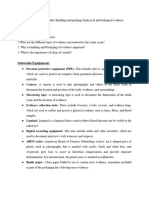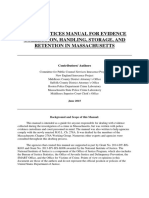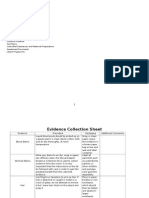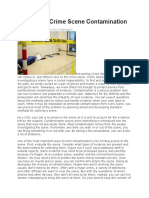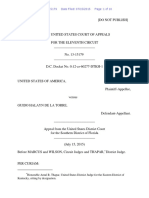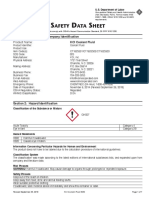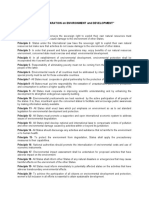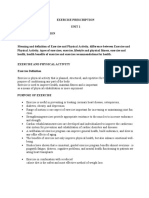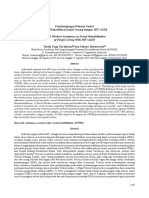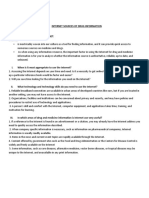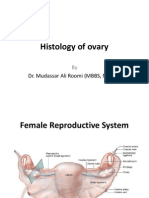The main focus of any investigator is to collect evidence, preserve that evidence, and to analysis
evidence. Collecting and preserving evidence is a crucial factor in any given case, that I why knowing the
steps to take while collecting it is so important. This article will go over methods of collecting in different
types of evidence.
When dealing with hair and fibers, you first want to choose the right container to package the
evidence in. Once you have found the right container, you then need to label the outside with
information such as the date it was obtained, the investigator’s name or initials, and the case name and
number. The investigator should obtain 25 combed and pulled hairs from all parts of the head and pubic
region, with each region of the body being packaged separately. If the evidence is hair from an animal,
at least 50 hairs are to be combed from all parts of the animal and packaged separately. When possible,
submit the entire garment in a sealed paper fold or envelope as the inner packaging. While collecting
fibers, be cautious of contamination from your hands, clothes or tweezers; to collect fibers, a sticky note
could be used to secure fiber evidence. Fold note and place in envelope and then label it. You could also
apply tape repeatedly to the lift the fiber and then label with a permanent marker. Submit the evidence
to the lab for collection.
For sexual assault evidence, some states and departments have their own kits, but most have a
standardized kit to collect any evidence that would be associated with sexual assault. The sexual assault
victim is to be examined in a hospital or a physician’s office using a sexual assault evidence kit to collect
vaginal, oral, and anal evidence. Most kits also include ways to collect evidence from the fingernails,
nasal cavities, and ways to collect hair and blood samples. All evidence collected from the sexual assault
kits are to be refrigerated and sent to the lab immediately.
When it comes to arson and fire debris, you first want to make sure that you have an air tight
container that is not flammable. The information that is to be put on the outside of the container
includes, the identity of the evidence, date and time that it was obtained, the investigator’s name or
initials, the date and time that the evidence was obtained, and the case number and name. The
investigators will need to look for things like candles, cigarettes, fused chemical masses, and any
electronic or mechanical devices an arsonist may have used. When collecting the evidence, the
investigators would want to collect from the origin of the fire and in the unburned areas around the fire
while looking for burn trails, cloth or paper, and removal of personal property or commercial inventory.
Blood and bodily fluid are a very important piece of evidence in any case, this is why it is
imperative that only qualified medical personal or investigators collect blood or bodily fluid samples
from a crime scene. The packaging for blood and bodily fluids need to be cotton cloth or swabs, and the
container that is used to seal the cotton cloth or swabs cannot be plastic. The outside of the container
should be labeled with all of the information that we have previously mentioned, but also the location
the evidence was found at the scene or on the body of the victim. After being collected, blood or bodily
fluid is to be dried before sealing into the container. When the blood or bodily fluid is in the snow or in
water, collect suspected blood or bodily fluid immediately to avoid further contamination. Eliminate as
much snow as possible, and place in a clean and airtight container. Freeze the evidence and submit to
the laboratory as soon as possible. Any clothing that has evidence on it should be air dried, wrapped in
paper, and placed in an airtight container.
Collecting controlled substances starts with finding the right container. The container used for
plant material or non-liquids, would be significantly different than a container used for a liquid. Liquids
�are to be collected in a bottle or jar that has a stopper or sealable lid. Always mark fragile on a glass jar
to prevent any destruction to the evidence. Evidence should be sealed with tamper evidence tape or
even heat-sealed. Submitting any plant material, the sample must be dry, otherwise the sample will
begin to mold inside the plastic if its damp or wet. If submitting an entire plant, be sure to cut the plants
off at the soil line.
The last evidence type that we will be looking at is plastic and tape. Plastic evidence should
always be preserved in the condition that it was found in. Tape evidence should be handled by wearing
non-powdered gloves to ensure that the tape won’t be contaminated. If either type of evidence is
attached to a bulkier item, the entire item should be packaged and sent to the lab. When the evidence
needs to be detached or cut, document every step of the process. Evidence should be labeled with the
date and time, investigator’s name or initials, case number and name, and the identity of the evidence.
